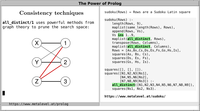Solving Sudoku with Prolog
Prolog solution
Prolog is extremely well suited for
solving combinatorial
tasks like Sudoku.
| Video: |

|
For example, using CLP(ℤ) constraints, a
valid Sudoku board can be concisely expressed like this:
sudoku(Rows) :-
length(Rows, 9),
maplist(same_length(Rows), Rows),
append(Rows, Vs), Vs ins 1..9,
maplist(all_distinct, Rows),
transpose(Rows, Columns),
maplist(all_distinct, Columns),
Rows = [As,Bs,Cs,Ds,Es,Fs,Gs,Hs,Is],
blocks(As, Bs, Cs),
blocks(Ds, Es, Fs),
blocks(Gs, Hs, Is).
blocks([], [], []).
blocks([N1,N2,N3|Ns1], [N4,N5,N6|Ns2], [N7,N8,N9|Ns3]) :-
all_distinct([N1,N2,N3,N4,N5,N6,N7,N8,N9]),
blocks(Ns1, Ns2, Ns3).
Like all pure Prolog programs,
this predicate can be used in all directions. You can
use it to:
- complete partial squares
- test complete squares
- generate all Sudoku Latin squares.
For example, we can use the code to generate valid
Sudoku boards:
?- sudoku(Rows), maplist(label, Rows), maplist(portray_clause, Rows).
[1,2,3,4,5,6,7,8,9].
[4,5,6,7,8,9,1,2,3].
[7,8,9,1,2,3,4,5,6].
[2,1,4,3,6,5,8,9,7].
[3,6,5,8,9,7,2,1,4].
[8,9,7,2,1,4,3,6,5].
[5,3,1,6,4,2,9,7,8].
[6,4,2,9,7,8,5,3,1].
[9,7,8,5,3,1,6,4,2].
Rows = [[1,2,3,4,5,6,7,8,9]|...]
A partial instantiation of the rows turns this into
a completion task, which is what we commonly
understand as a Sudoku puzzle.
Source file
Prolog source file: sudoku.pl
The source file contains:
- the Prolog formulation of Sudoku puzzles which is shown above
- PostScript instructions for
showing animations of
the search process
- sample Sudoku instances, available is problem/2.
You can try it with Scryer Prolog:
$ scryer-prolog sudoku.pl
Sample query and answer:
?- problem(1, Rows),
sudoku(Rows),
maplist(labeling([ff]), Rows),
maplist(portray_clause, Rows).
[1,5,6,8,9,4,3,2,7].
[9,2,8,7,3,1,4,5,6].
[4,7,3,2,6,5,9,1,8].
[3,6,2,4,1,7,8,9,5].
[7,8,9,3,5,2,6,4,1].
[5,1,4,9,8,6,2,7,3].
[8,3,1,5,4,9,7,6,2].
[6,9,7,1,2,3,5,8,4].
[2,4,5,6,7,8,1,3,9].
Rows = [[1,5,6,8,9,4,3,2,7]|...]
Animations
If you have the PostScript viewer "gs" installed, you can view an
animation of the constraint solving process.
Sample PostScript file, a self-contained saved animation
for a Sudoku puzzle (open it with "gv" or "gs" to view
it): solved.ps.gz
Here is a shell command that you can try,
using show/2 to animate the search:
$ scryer-prolog -g 'problem(1,Rows),show([ff],Rows)' sudoku.pl | \
gs -dNOPROMPT -g680x680 -dGraphicsAlphaBits=2 -r150 -q
The arguments of show/2 are:
- a list of labeling options
- a list of 9 rows that are to be
completed to a Sudoku Latin square. Each row is a list of 9
variables, which can also be already instantiated to integers to
fill in initial elements.
As a side-effect, you see an animation of the constraint solving
process. To make the search more interesting, you can
replace all_distinct/1 with the weaker
constraint all_different/1 in the source file.
Here's an intermediate state:

And here is a picture of a finished animation:

Further reading:
Neumerkel
at
al., Visualizing
Solutions with Viewers.
More CLP(ℤ) examples: https://github.com/triska/clpz
More about Prolog: The Power of Prolog
Main page



